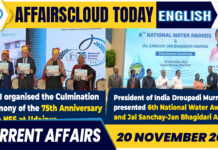 In June 2025, Salkhan Fossils Park, also known as Sonbhadra Fossils Park, located in Salkhan village, Sonbhadra district of Uttar Pradesh (UP), was added to the Tentative List of United Nations Educational, Scientific and Cultural Organization (UNESCO) World Heritage Sites(WHS).
In June 2025, Salkhan Fossils Park, also known as Sonbhadra Fossils Park, located in Salkhan village, Sonbhadra district of Uttar Pradesh (UP), was added to the Tentative List of United Nations Educational, Scientific and Cultural Organization (UNESCO) World Heritage Sites(WHS).
- The recognition marks the first formal step towards its inscription as a UNESCO World Heritage Site.
Note: The UNESCO Tentative List is a list of sites a country plans to nominate for World Heritage status, and being on this list is the first required step to show the site’s global value and meet UNESCO’s selection criteria.
About Salkhan Fossils Park:
i.Area Covered: Approximately 25 hectares.
ii.Geological Significance: Contains stromatolites, layered sedimentary formations created by ancient cyanobacteria (blue-green algae)
- Fossils are estimated to be around 1.4 billion years old, dating back to the Mesoproterozoic era (1.6 to 1.0 billion years ago).
- Embedded in Bhander limestone of the Kaimur range, part of the Vindhyan Supergroup (UP), one of the oldest and best-preserved Proterozoic rock formations in the world.
iii.Ecological Context :Situated within the Kaimoor Wildlife Sanctuary(KWLS) (UP), rich in dry deciduous forests and riverine ecosystems.
iv.Scientific Importance: Offers evidence of the Great Oxidation Event, critical for understanding early atmospheric changes.
- Hosts rare, well-preserved stromatolite morphologies (columnar, domal, stratiform)
v.Legal Protection:
Protected under multiple Indian environmental laws including:
- Wildlife (Protection) Act, 1972
- Forest (Conservation) Act, 1980
- Indian Forest Act, 1927
- Biological Diversity Act, 2002
- Falls within an Eco-Sensitive Zone (ESZ) surrounding the sanctuary.
Steps Toward UNESCO Status:
i.The Uttar Pradesh Eco-Tourism Development Board (UPETDB), in coordination with the Government of India (GoI), had prepared a detailed report for submission to UNESCO, which included scientific validation, documentation, and an on-site inspection by a UNESCO evaluation team.
ii.A Memorandum of Understanding (MoU) was signed on 26th June 2024 between the UPETDB and Lucknow (Uttar Pradesh)-based Birbal Sahni Institute of Palaeosciences (BSIP) for scientific assessment.
iii.The final documentation is in progress, and UNESCO is expected to evaluate the site within the next one to two years. Upon approval, it may be officially designated as a World Heritage Site by 2027.
Government Initiatives and Tourism Development:
The Government of UP, under the leadership of Chief Minister(CM) Yogi Adityanath, has undertaken key eco-tourism initiatives to develop the park:
- Rs 1.5 crore has been sanctioned for infrastructure development, including interpretive centres, nature trails, and visitor amenities.
- Vistadome coaches have been introduced on tourist trains connecting ecological sites like Dudhwa Tiger Reserve and Katarniaghat Wildlife Sanctuary in UP.
UNESCO World Heritage Sites in India:
i.As of June 2025, India has a total of 43 sites on the World Heritage List(WHL) recognised by UNESCO.
- Cultural – 35
- Natural – 7
- Mixed – 1 (Khangchendzonga National Park)
ii.India has a total of 63 sites on UNESCO’s Tentative List as of June 2025.
About United Nations Educational, Scientific and Cultural Organisation (UNESCO):
Director-General (DG)– Audrey Azoulay
Headquarters- Paris, France
Established-1945
Member Nations– 194




